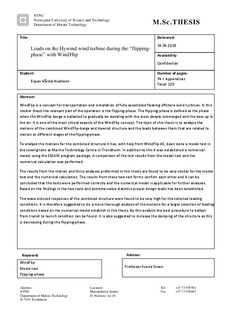Loads on the Hywind wind turbine during the "flipping-phase" with WindFlip
Master thesis
Permanent lenke
http://hdl.handle.net/11250/237787Utgivelsesdato
2010Metadata
Vis full innførselSamlinger
- Institutt for marin teknikk [3431]
Sammendrag
WindFlip is a concept for transportation and installation of fully assembled floating offshore wind turbines. In this master thesis the relevant part of the operation is the flipping-phase. The flipping-phase is defined as the phase when the WindFlip barge is ballasted to gradually be standing with the stern deeply submerged and the bow up in the air. It is one of the most critical aspects of the WindFlip concept. The topic of this thesis is to analyze the motions of the combined WindFlip-barge and Hywind structure and the loads between them that are related to motion at different stages of the flipping-phase.
To analyze the motions for the combined structure it has, with help from WindFlip AS, been done a model test in the towing tank at Marine Technology Centre in Trondheim. In addition to this it was established a numerical model using the SESAM program package. A comparison of the test results from the model test and the numerical calculation was performed.
The results from the motion and force analyses preformed in this thesis are found to be very similar for the model test and the numerical calculation. The results from these two test forms confirm each other and it can be concluded that the tests were performed correctly and the numerical model is applicable for further analyses. Based on the findings in the two tests and extreme-value statistics proper design loads has been established.
The wave induced responses of the combined structure were found to be very high for the selected loading conditions. It is therefore suggested to do a more thorough analysis of the motions for a larger selection of loading conditions based on the numerical model establish in this thesis. By this analysis the best procedure to ballast from transit to launch condition can be found. It is also suggested to increase the damping of the structure as this is decreasing during the flipping-phase.
